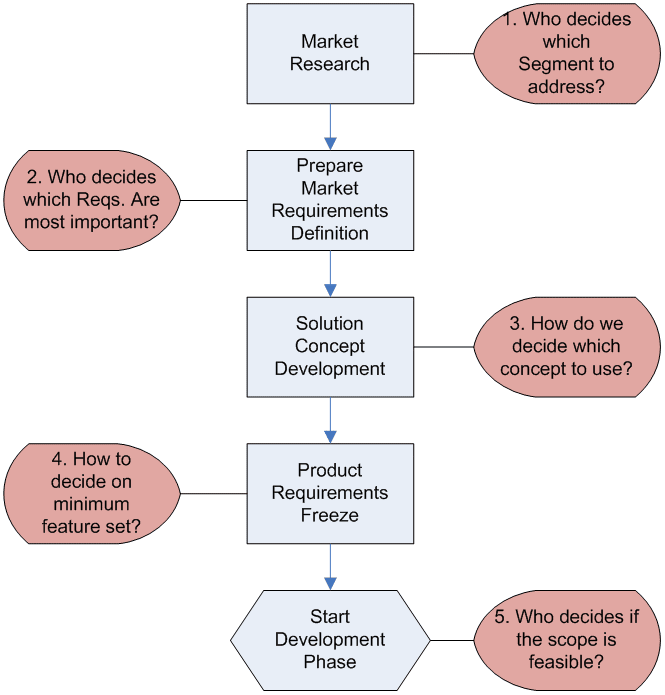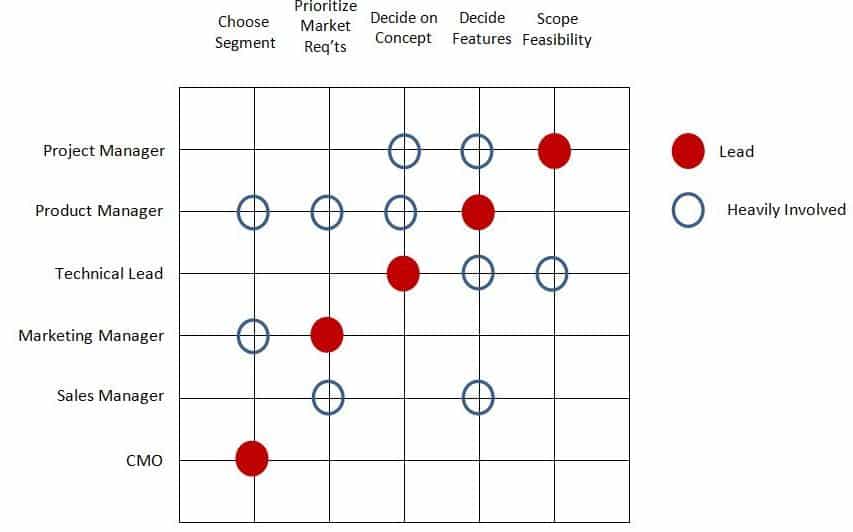Teams that develop new products are challenged to produce a high-quality, valuable solutions in as short a time as possible and within a tight budget. We all know that slippage in time-to-market; decreased functionality, or increased cost can have major negative consequences for the business, and may even determine the success or failure of a new product launch.
One major cause of such slippage is confusion within the team around roles and responsibilities. If nobody on the team knows who is empowered to make a certain decision, the decision can go unmade, wasting valuable time, or be made by the wrong person – the person who does not have the knowledge to make such decisions.
Many new product development (NPD) teams try to prevent this kind of “wheel spinning” by writing extensive Role Descriptions for each member of the team, attempting to make it clear who is “in charge” of each type of decision. Or they may use more generic corporate job descriptions for the same purpose.
The problem is that most NPD projects are fluid and dynamic and problems may arise for which there is no clear owner. A common example occurs in deciding the feature set of a product or solution at its launch date. Who can decide? Is it the Project Manager? The Product Manager? The funding Business Leader? A major customer? Indecision in the feature set, or “creeping featurism” is one of the leading causes of project slippage and it’s almost always due to confusion about who can make the call.
How to diagnose and correct Pinch-Points in your company?
A good way to diagnose and correct these problems within your business culture is to look for the “Pinch-Points” in your NPD process, and then define the correct resolution path for each one. A Pinch-Point is an event in your NPD process in which there is frequently confusion, misunderstanding or disagreement about roles and responsibilities.
The way to find them is to gather a group of core team veterans, sketch out parts of the NPD process, and then list problems that occur in those parts of the process from past or ongoing projects.
A hypothetical example is illustrated in the first diagram below: It shows a typical simplified process to produce a Product Requirements Definition – the set of features to be provided by the product or solution at launch.
After sketching and discussing this process with a team of experienced NPD people in your company, they may come up with something like the five Pinch-Points shown in the figure, with statements like: “It’s never really clear how we decide which segment of customers we are targeting.
Who decides that?” Or “we always come up with three or four great concepts to meet the market requirements, but then we stall for a time while we try to figure out which one to use.” These Pinch-Points are different for different organizations, so it is important to discover your own set and to prioritize them by the ones that seem to occur most often or cause the most churn.
The next step is to gather the team again with the prioritized Pinch-Points and decide upon what should happen in each of these cases – what is the clearest and fastest way to resolve each situation?
As an example, in deciding which market segments are the most important to study and address, you may decide that the Chief Marketing Office (CMO) should make that call because she has the most strategic and objective knowledge about where the company is going and how the markets are trending. Nonetheless, the Product Manager and the Sales Manager should he consulted and play major role.
A good way to clarify roles and responsibilities is to use a “Circle-Dot” diagram or matrix, as illustrated in the second figure below. In this figure, similar to a RACI chart (Recommends, Approves, Consulted, Informed), the Pinch-Points are listed across the top of the matrix and professional roles are placed along the left side.
A solid dot is placed at a vertex to indicate the role that should take the leadership in deciding or resolving the issue. Open circles indicate the people who should be heavily involved in the decision, but the leader clearly decides. The group of project veterans may fill-out the Circle-Dot something like the picture below, then they should have it vetted and approved by upper management.
After the team has illuminated the Pinch-Points and clarified the role to take responsibility for making the decision on each one, it is also important to decide and agree upon a clear escalation process in case important team members don’t agree with the decision.
We have seen that using these tools at the beginning of a project can help to make the project go much faster and more efficiently. Little time is wasted in wondering who is going to make the decision, or on second-guessing and back-tracking on decisions. Finding the Pinch-Points, deciding on the proper course of action and decision maker when they are reached, and clarifying the escalation path for disagreements will streamline your NPD project.


